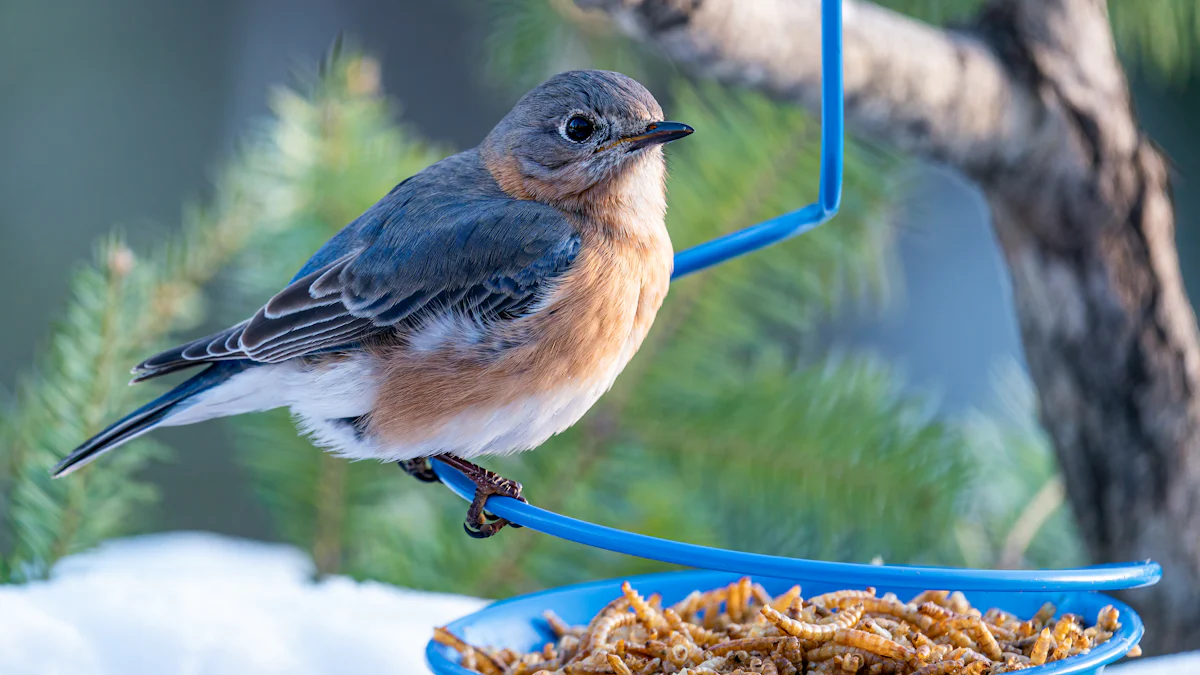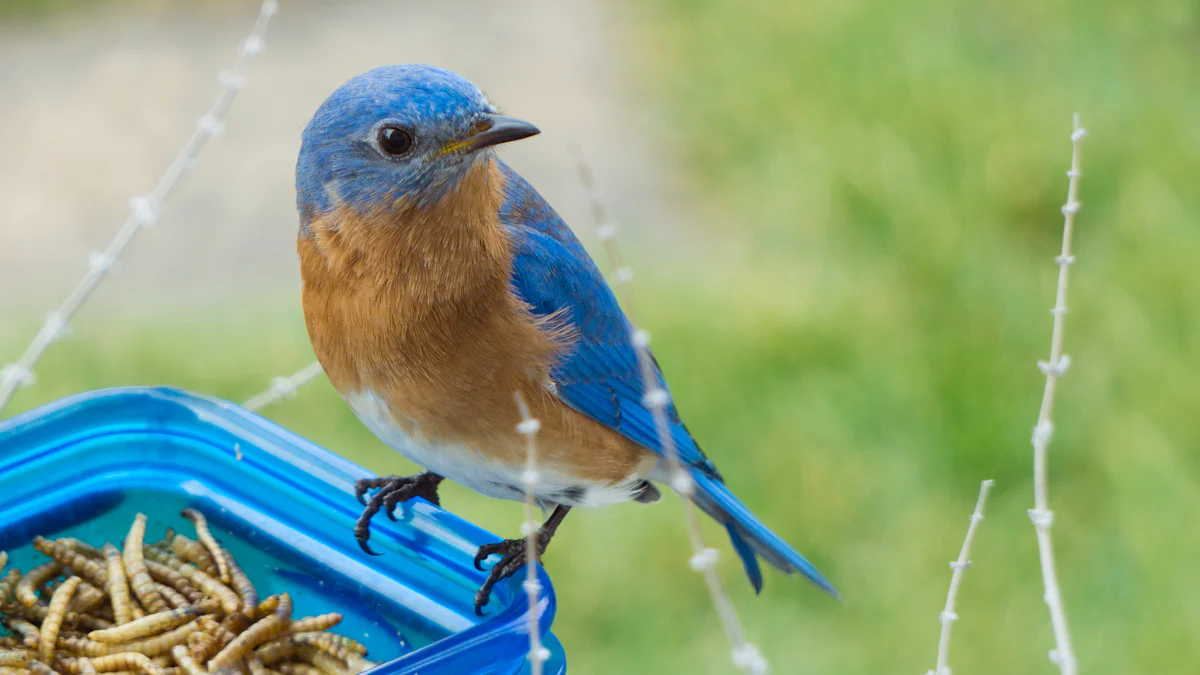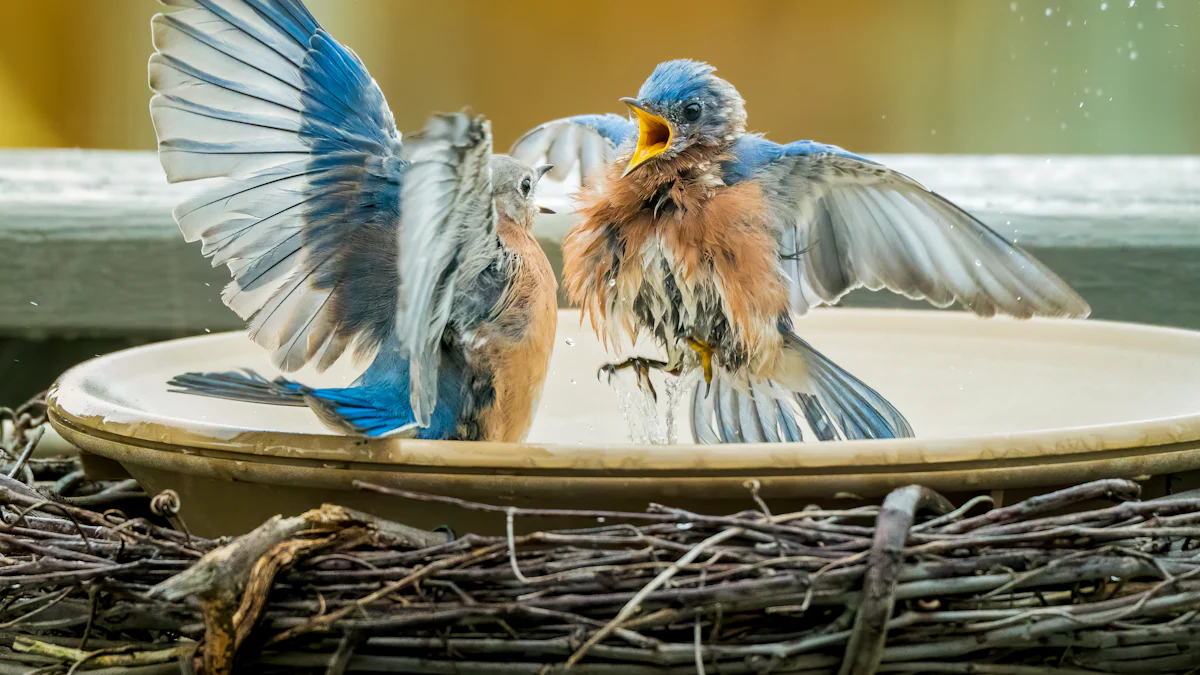
Have you ever wondered why birds love dried mealworms to birds so much? These little treats pack a punch of nutrition! They’re loaded with protein, fats, and vitamins that help birds stay healthy and strong. Simply mix the dried mealworms to birds into your regular bird seed mix or serve them alone, and watch your feathered friends flock to your yard.
Key Takeaways
- Dried mealworms are healthy snacks for birds. They have protein, fats, and important vitamins to keep birds strong and active.
- Soaking dried mealworms in water makes them more tempting. This is helpful during nesting time when birds need more water.
- Adding dried mealworms to other bird food gives a balanced meal. It brings different bird types and helps them stay healthy.
Benefits of Serving Dried Mealworms to Birds
Nutritional Value of Dried Mealworms
Dried mealworms are like a superfood for birds. They’re packed with about 50% protein, which helps birds grow strong and repair their feathers. Protein is especially important during molting or when young birds are developing. Plus, these little snacks are loaded with fats and carbohydrates, giving birds the energy they need to fly, forage, and stay active.
But that’s not all! Dried mealworms also contain essential vitamins and minerals. For example, vitamin A supports healthy eyes, while vitamin D helps birds absorb calcium for stronger bones. B vitamins and essential fatty acids round out the nutritional profile, making dried mealworms a well-balanced treat. I’ve noticed that when I add them to my feeders, the birds seem more vibrant and energetic. It’s like giving them a boost of health in every bite!
Birds That Enjoy Dried Mealworms
You might be wondering, “Which birds will actually eat these?” Well, I’ve seen a variety of species flock to my yard for dried mealworms. Some of the most common visitors include:
- Blue Jays
- Robins
- Wrens
- Chickadees
- Woodpeckers
- Finches and Sparrows
Each bird seems to have its own way of enjoying them. Robins love finding mealworms on the ground, while chickadees and wrens prefer grabbing them from feeders. Even woodpeckers can’t resist! Offering dried mealworms to birds not only attracts a diverse group but also supports their health and energy needs. It’s a win-win for bird lovers and wildlife alike.
Preparing Dried Mealworms for Birds

Should You Moisten Dried Mealworms?
I’ve found that moistening dried mealworms can make a big difference in how birds respond to them. Rehydrating them restores their natural texture and flavor, making them more appealing—especially to birds that prefer moist food, like robins and bluebirds. It’s easy to do! Just soak the mealworms in warm water for about 20-30 minutes. Once they plump up, they look and feel more like live insects.
This little trick is especially helpful during nesting and breeding seasons. Birds need extra hydration and energy during these times, and rehydrated mealworms provide both. I’ve noticed that when I offer them this way, more bird species visit my yard. It’s like rolling out the red carpet for your feathered friends!
If you’re new to this, start by moistening a small batch and see how the birds react. You might be surprised at how quickly they flock to your feeders.
Mixing Mealworms with Other Bird Foods
Another great way to serve dried mealworms to birds is by mixing them with other foods. I like to combine them with seeds, nuts, and even small pieces of fruit. This creates a balanced meal that supports the birds’ overall health. Mealworms are packed with protein and fat, but they don’t have everything birds need. Adding other foods ensures they get a variety of nutrients.
Here’s what works well for me:
- I mix mealworms with traditional birdseed or suet. This combination attracts a wide range of species.
- During winter, I add high-energy foods like suet to help birds stay warm.
- Sometimes, I sprinkle the mix on a platform feeder or layer it in a hopper feeder.
Experimenting with different combinations can be fun. You’ll quickly learn what your local birds love most. Plus, it’s a joy to watch them enjoy a meal you’ve prepared just for them!
Best Feeders for Serving Dried Mealworms to Birds

Types of Feeders to Use
When it comes to serving dried mealworms to birds, the type of feeder you choose can make a big difference. I’ve tried a few options, and each has its perks. Specialized mealworm feeders are my go-to. They often have small trays or mesh compartments that securely hold the mealworms. This keeps them visible to birds while preventing spillage. It’s a win-win!
For ground-feeding birds like robins, scattering mealworms on the soil or placing them in a shallow dish works wonders. It mimics their natural foraging behavior and makes the food easy to access. If you’re worried about squirrels or larger birds stealing the mealworms, consider using feeders designed to exclude them. Some feeders even come with covers to keep the mealworms dry and fresh.
I’ve also experimented with peanut-style feeders adapted for mealworms. They’re great for attracting smaller birds while keeping the food safe from rain. Adding accessories like drainage trays or baffles can help maintain cleanliness and make feeding even more efficient.
Features of an Ideal Mealworm Feeder
Choosing the right feeder isn’t just about style—it’s about functionality too. Here’s what I look for in a good mealworm feeder:
| Feature | Description |
|---|---|
| Durable Material | Sturdy materials that can handle weather changes. |
| Appropriate Opening Sizes | Openings between 1.5″ and 1.75″ to allow small birds in while keeping larger ones out. |
| Cleanable Trays | Removable trays for easy cleaning and to prevent mealworms from escaping. |
| Roof for Protection | A roof to shield mealworms from rain and direct sunlight. |
| Easy to Fill and Clean | A simple design that makes refilling and cleaning hassle-free. |
| Deter Larger Birds and Animals | Features like baffles or tamper-resistant designs to keep squirrels and larger birds away. |
| Multiple Exit Points | More than one exit to ensure birds don’t get trapped inside. |
I’ve found that feeders with tall sides and drainage holes are especially helpful. They keep the mealworms from escaping and prevent water from pooling. A rain guard or roof is a must-have too. It keeps the mealworms fresh and ready for the birds to enjoy.
Simply mix the mealworms into your regular bird seed mix or provide them alone in a dish or hopper feeder. Then, sit back and watch the birds come eating. Dried mealworms are nutritious and provide a balanced blend of protein, fat, and fiber to promote healthy, vigorous birds.
How Often to Feed Dried Mealworms to Birds
Seasonal Feeding Tips
Feeding birds isn’t a one-size-fits-all activity. I’ve learned that the time of year plays a big role in how often I should offer dried mealworms to birds. In spring, I like to increase the frequency to daily or every other day. Birds need extra protein during this time to lay eggs and feed their young. Orioles, for example, rely on a consistent food source during the breeding season.
In winter, I adjust my approach. Birds need more fat to stay warm, so I mix mealworms with high-energy foods like suet. I usually feed them two to three times a week during the colder months. This keeps them fueled without overfeeding. As fall approaches and some species migrate, I scale back to once or twice a week. It’s all about understanding their seasonal needs and adjusting accordingly.
Balancing Mealworms with Other Foods
While dried mealworms are nutritious, they don’t provide everything birds need. I’ve found that mixing them with other foods creates a more balanced diet. For example, I add sunflower hearts for healthy fats and fresh fruit for vitamins. Suet cakes or balls are another great addition, especially in winter when birds need extra energy.
Here’s my go-to mix:
- Black sunflower seeds for protein
- Peanuts for an energy boost
- Mealworms for protein and fat
This combination keeps my feathered visitors happy and healthy. Simply mix the mealworms into your regular bird seed mix or provide them alone in a dish or hopper feeder. Then, sit back and watch the birds come eating. Dried mealworms are nutritious. They provide a blended balance of protein, fat, and fiber to promote healthy, vigorous birds.
Storing Dried Mealworms Safely
Proper Storage Practices
Storing dried mealworms the right way is key to keeping them fresh and safe for birds. I’ve learned a few tricks that work wonders. First, I always keep them in a cool, dark spot at room temperature. Heat and sunlight can ruin their quality fast. Airtight containers are a must. They block out moisture, air, and pests, which can spoil the mealworms.
To go the extra mile, I toss a desiccant packet into the container. It absorbs any humidity that sneaks in. If I have a big batch of mealworms, I freeze the extras. Freezing at temperatures below -15°C keeps them fresh for over six months. When I need more, I just thaw them out and they’re good as new!
Here’s a quick checklist I follow:
- Use airtight containers.
- Store in a cool, dark place.
- Add desiccants to control moisture.
- Freeze surplus mealworms for long-term storage.
These steps make sure the mealworms stay in top condition, ready to nourish the birds.
Keeping Mealworms Fresh and Safe
Improper storage can lead to big problems. I’ve seen what happens when moisture gets in—mold starts growing, and the mealworms become unusable. Pests can also sneak in if the packaging isn’t secure. To avoid this, I check my mealworms regularly. If I notice any odd smells or changes in texture, I remove the bad ones right away.
Buying from trusted sources helps too. High-quality mealworms last longer and are less likely to spoil. When stored properly, they can stay fresh for a year or more. I always remind myself: a little effort in storage goes a long way in keeping the birds happy and healthy.
Pro Tip: Keep mealworms dry and sealed to prevent spoilage. Birds deserve the best, and proper storage ensures they get it!
Dried mealworms are a game-changer for bird lovers like me. They’re packed with nutrients that keep birds healthy, especially during winter and spring. I love how easy they are to handle and serve. Whether you rehydrate them, mix them with seeds, or use specialized feeders, they attract a variety of birds to your yard.
Here’s why I recommend them:
- Rehydrated mealworms bring more species to your feeders.
- Specialized feeders prevent waste and keep mealworms fresh.
- Ground feeding mimics natural foraging, perfect for robins and sparrows.
- Mixing mealworms with other foods creates a balanced diet for birds.
Adding mealworms to your feeding routine doesn’t just help birds—it makes birdwatching more exciting. Watching vibrant species thrive in your backyard is so rewarding. Plus, it’s a simple way to support wildlife and connect with nature.
So, why wait? Simply mix the mealworms into your regular bird seed mix or provide them alone in a dish or hopper feeder. Then, sit back and enjoy the show. You’ll love seeing healthy, happy birds flock to your yard! 🐦
FAQ
How do I attract more birds with dried mealworms?
Place mealworms in a visible spot, like a platform feeder. Mix them with seeds or fruit. Rehydrating them can also make them more appealing.
Can I feed dried mealworms to birds year-round?
Yes! Birds love mealworms in every season. Increase feeding in spring and winter when they need extra energy for nesting or staying warm.
Are dried mealworms safe for baby birds?
Absolutely! Dried mealworms provide protein for growing chicks. Rehydrate them first to make them softer and easier for parent birds to feed their young.


